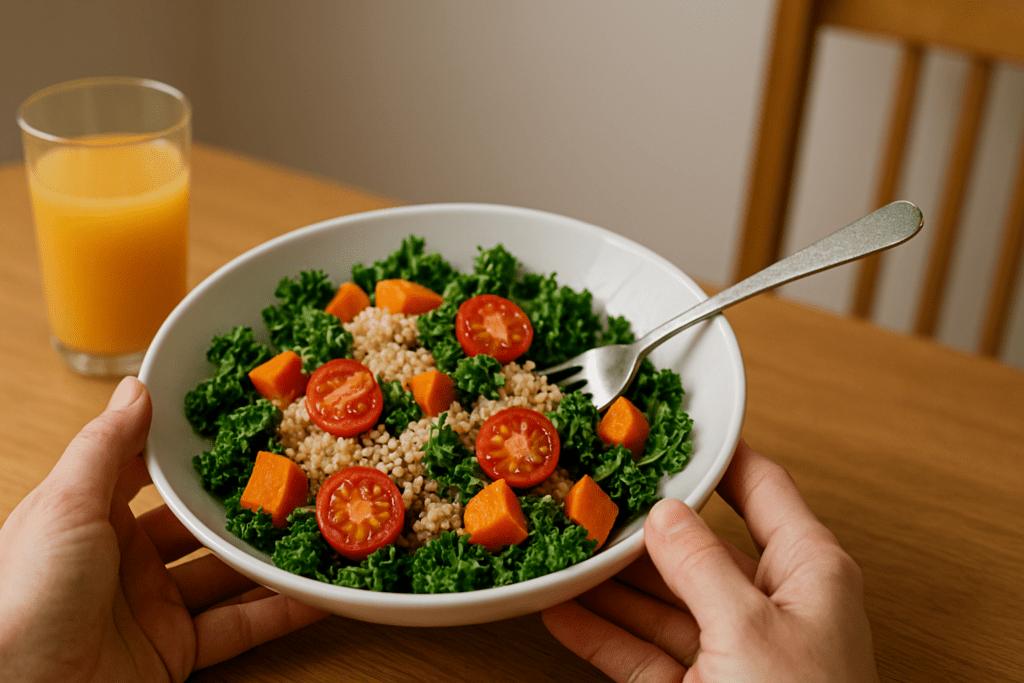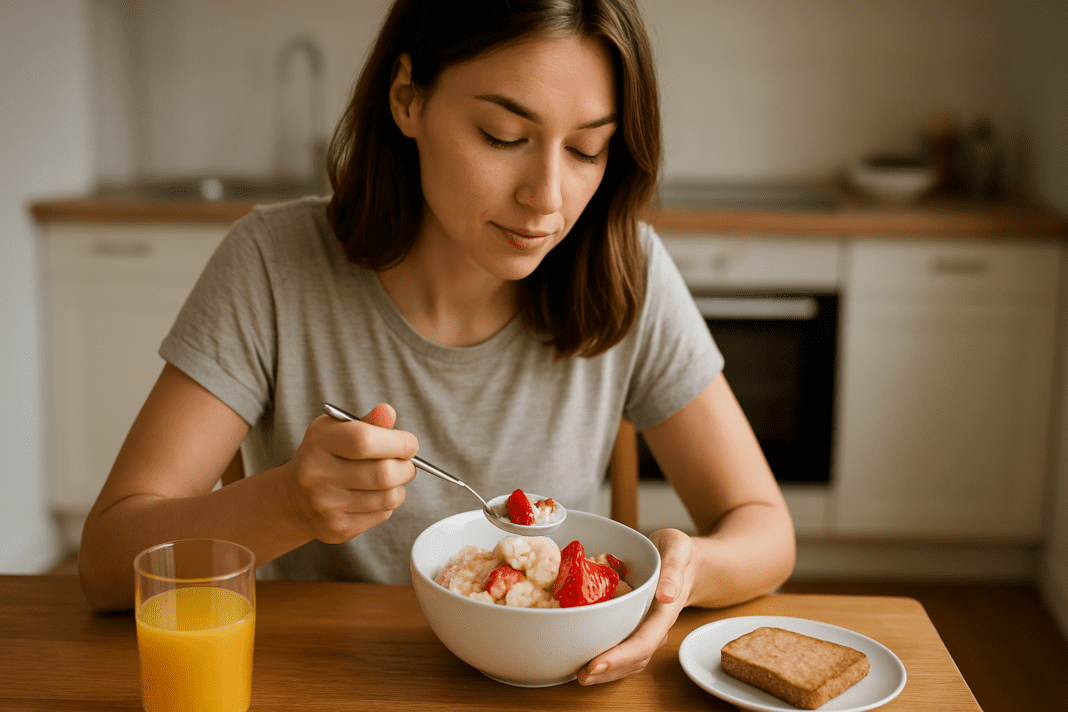In today’s fast-paced world, finding the time and inspiration to cook healthy meals can feel like a challenge. Yet, supporting long-term wellness begins with daily habits, and what we eat throughout the day plays a critical role in both physical health and mental clarity. Making nutritious choices isn’t about restriction; it’s about incorporating balance, variety, and pleasure into our meals. In this comprehensive guide, we explore healthy recipes for breakfast, lunch, and dinner that are not only satisfying and delicious but also grounded in the principles of nutritional science. Whether you’re a working professional, a busy parent, or a college graduate striving to maintain a healthier lifestyle, these ideas will help you prioritize your well-being one plate at a time. More importantly, we integrate science-backed insights and practical strategies to help you understand the deeper benefits of healthy food recipes for breakfast, lunch, and dinner—transforming everyday meals into powerful tools for longevity and vitality.
You may also like: Smart Healthy Eating Tips for Busy Professionals: How to Stay Nourished When You’re Always on the Go
The Importance of Nutrient-Dense Meals for Daily Wellness
A balanced diet built around whole, minimally processed foods offers profound health benefits that extend beyond weight management. Whole foods provide a spectrum of essential nutrients—vitamins, minerals, fiber, antioxidants, and healthy fats—that fuel the body’s biological processes, enhance cognitive performance, and support immune function. The rhythm of our daily eating habits significantly affects our energy levels, mood, digestion, and even hormonal balance. This is why eating healthy foods every day for breakfast, lunch, and dinner is not just a matter of physical nourishment but a cornerstone of holistic wellness.
For instance, studies show that starting the day with a protein-rich breakfast can reduce cravings later in the day, stabilizing blood sugar levels and improving focus. Similarly, lunches rich in leafy greens and healthy fats can combat midday fatigue and support heart health. Dinner, when prepared mindfully, provides an opportunity to wind down with foods that promote rest and recovery. Thus, incorporating healthy breakfast, lunch, and dinner meals into your routine ensures that every stage of the day contributes to your physical and emotional resilience.
Mindful Meal Planning: The Foundation of a Balanced Lifestyle
Planning ahead is one of the most effective strategies for sustaining a healthy diet. When meals are thoughtfully prepared in advance, we are less likely to rely on processed foods or last-minute takeout that often lacks nutritional value. Mindful meal planning encourages us to consider not only what we eat, but how and why we eat. It creates opportunities to tune in to our hunger cues, reduce stress around food decisions, and reconnect with the simple act of nourishment.
To get started, consider setting aside time once a week to plan your meals and grocery list. Focus on diversity—incorporating a wide range of colors and textures throughout the day—to maximize nutrient intake. Try mixing up your menu by rotating healthy food recipes for breakfast, lunch, and dinner to prevent boredom and keep your taste buds engaged. This strategy also supports a more balanced intake of micronutrients and phytochemicals found in different fruits, vegetables, grains, and proteins.

Fueling the Morning: Healthy Breakfast Recipes for Energy and Focus
Breakfast is often referred to as the most important meal of the day, and for good reason. After a night of fasting, the body needs replenishment to kickstart metabolism, regulate blood sugar, and prepare for the day’s cognitive and physical demands. However, many people fall into the trap of either skipping breakfast or opting for high-sugar, low-nutrient foods that lead to energy crashes.
A healthier approach involves incorporating high-quality proteins, complex carbohydrates, and healthy fats into your morning meal. For example, a veggie-packed frittata made with eggs, spinach, bell peppers, and a sprinkle of feta provides essential B vitamins and iron. Pair it with a slice of whole grain toast and avocado for lasting energy. Another option is overnight oats prepared with chia seeds, almond milk, and fresh berries—a combination rich in fiber, omega-3 fatty acids, and antioxidants.
Smoothies also offer a convenient and nutrient-dense way to start the day. Blend Greek yogurt, a banana, spinach, frozen berries, and flaxseed for a refreshing drink that delivers protein, potassium, vitamin C, and fiber. By regularly incorporating such healthy breakfast options into your meal plan, you support your body’s natural rhythms and reduce the temptation to reach for sugary snacks later in the day.
Midday Renewal: Healthy Lunches That Nourish and Rejuvenate
Lunch serves as a pivotal point in the day when energy levels may dip, and stress levels can rise. A thoughtfully prepared lunch can restore vitality, regulate blood sugar, and prevent the post-lunch slump that interferes with productivity. Unfortunately, lunch is also the meal most likely to be compromised by time constraints or poor planning. That’s why incorporating healthy lunch ideas into your weekly routine is crucial.
Consider a quinoa salad with roasted vegetables, chickpeas, and a lemon-tahini dressing. This combination offers complete plant-based proteins, dietary fiber, and anti-inflammatory nutrients. Alternatively, grilled salmon paired with a kale and farro salad provides omega-3 fatty acids and iron, supporting brain and cardiovascular health. Wraps made with hummus, turkey, spinach, and shredded carrots can also deliver flavor and nutrients in a portable format that’s perfect for busy afternoons.
Even leftovers from a healthy dinner can become an effortless lunch the next day. Transform last night’s roasted vegetables into a warm grain bowl or use extra grilled chicken to top a fresh green salad. When you consistently prioritize healthy lunch choices, you’re not only protecting your long-term health but also enhancing your immediate mental focus and emotional balance.
Ending the Day Right: Healthy Dinner Recipes for Restoration and Sleep
Dinner is more than a meal; it is a ritual that marks the transition from the active part of the day to rest and recovery. Eating a balanced dinner that includes lean protein, fiber, and calming nutrients can help the body unwind and prepare for restful sleep. Unlike heavy, late-night meals that disrupt digestion and circadian rhythms, light but nourishing dinners encourage metabolic balance and relaxation.
A grilled chicken stir-fry with bok choy, bell peppers, and brown rice is both satisfying and supportive of hormonal balance, thanks to the B vitamins and magnesium found in the ingredients. Lentil soup with carrots, celery, and turmeric offers plant-based protein and anti-inflammatory compounds, while also promoting satiety. For those who prefer lighter fare, a zucchini noodle bowl with grilled shrimp, cherry tomatoes, and pesto is refreshing yet protein-rich.
What makes these dishes truly effective as healthy dinner options is their ability to provide steady, non-disruptive energy while avoiding blood sugar spikes that can interfere with sleep. When combined with mindful eating habits—such as turning off screens, eating slowly, and savoring flavors—healthy dinner meals become a form of self-care that supports restorative rest and overnight healing.
Everyday Superfoods to Include in Your Meals
Integrating nutrient-rich superfoods into your meals is a practical way to enhance the quality of your diet without complicating your routine. Superfoods are not exotic or expensive ingredients, but rather everyday items that deliver dense nutritional value. They can easily be incorporated into healthy foods to eat every day for breakfast, lunch, and dinner.
Examples include dark leafy greens like spinach and kale, which are rich in vitamin K, calcium, and fiber. Berries provide antioxidants and vitamin C, supporting skin health and immune function. Legumes such as lentils and chickpeas deliver plant-based protein and stabilize blood sugar. Fatty fish like salmon and sardines offer omega-3s, crucial for brain function and inflammation control.
Whole grains, including quinoa, oats, and farro, serve as excellent sources of complex carbohydrates and micronutrients. Nuts and seeds, including almonds, chia, and flax, contribute healthy fats, magnesium, and fiber. By weaving these superfoods into your meals, you amplify the health benefits of your daily routine without overhauling your entire diet. These additions can be subtle—a handful of walnuts in your oatmeal, a side of sautéed greens at dinner, or a topping of berries on your yogurt—but their impact on overall wellness is profound.

Balancing Macronutrients for Sustained Energy
One of the most overlooked aspects of healthy eating is the balance of macronutrients: carbohydrates, proteins, and fats. Each macronutrient plays a unique role in maintaining energy, satiety, and metabolic function. Understanding how to structure your meals around a balanced intake can transform how you feel throughout the day.
Carbohydrates should primarily come from complex sources like whole grains, fruits, and vegetables. These foods break down more slowly, providing a steady release of energy and supporting gut health through fiber. Protein sources, whether animal-based like chicken and eggs or plant-based like tofu and beans, are essential for muscle repair, immune function, and satiety. Healthy fats from avocados, olive oil, and nuts regulate hormones and support cognitive health.
A well-composed plate might include grilled tofu (protein), quinoa (complex carbohydrate), and sautéed kale (fiber and micronutrients) drizzled with olive oil (healthy fat). This structure can be applied to every meal, creating healthy food recipes for breakfast, lunch, and dinner that stabilize energy levels and reduce cravings. Over time, this balanced approach supports weight maintenance, mental clarity, and disease prevention.
Culinary Creativity: Keeping Healthy Meals Enjoyable
One of the most common misconceptions about healthy eating is that it has to be boring or repetitive. On the contrary, preparing healthy recipes for breakfast, lunch, and dinner can be an act of creativity and self-expression. With access to diverse ingredients and global culinary traditions, you can experiment with flavors, textures, and cooking methods to keep meals exciting.
Try infusing your dishes with international flavors—such as Moroccan spices in a chickpea stew, or Thai herbs in a vegetable curry. Use different cooking techniques like roasting, grilling, or spiralizing to add variety. Even the simplest meals can become memorable with the right seasoning, sauces, and presentation. Cooking should be joyful, not stressful. Approach each meal as an opportunity to nourish your body while enjoying the process.
Investing in good-quality kitchen tools, such as a sharp chef’s knife or a reliable blender, can make healthy meal prep easier and more enjoyable. Enlist your senses while cooking—smell the spices, admire the colors, and savor each bite. When meals are both nutritious and pleasurable, healthy eating becomes a sustainable and fulfilling lifestyle rather than a chore.
Smart Shopping for a Healthy Kitchen
A well-stocked kitchen is the foundation of consistent healthy eating. Thoughtful grocery shopping helps you stay on track with your wellness goals and prevents impulse purchases that can derail your intentions. Begin by creating a weekly shopping list that aligns with your planned meals, prioritizing whole foods over processed items.
Shop the perimeter of the grocery store, where fresh produce, lean proteins, and dairy are typically located. Aim to fill your cart with ingredients that form the basis of healthy breakfast, lunch, and dinner recipes: vegetables, fruits, whole grains, legumes, nuts, seeds, and lean proteins. Read labels carefully to avoid added sugars, sodium, and artificial additives.
Batch-cooking staples like brown rice, beans, or roasted vegetables can save time and support healthier choices throughout the week. Freezing portions of healthy meals also helps reduce waste and ensures you always have nutritious options on hand. When your kitchen is organized and stocked with wholesome ingredients, cooking at home becomes less daunting and more enjoyable.

Reflections on Eating with Intention
Beyond the physical aspects of nutrition, mindful eating invites us to reconnect with the experience of food. Eating with intention means slowing down, listening to your body’s cues, and appreciating the journey from farm to fork. This practice can improve digestion, reduce overeating, and enhance satisfaction.
Take a moment before each meal to pause and express gratitude. Minimize distractions by turning off screens and focusing on the flavors and textures of your food. Chew thoroughly and notice how different foods make you feel afterward. These simple habits can deepen your relationship with food and cultivate a sense of mindfulness that spills over into other areas of life.
When you approach healthy breakfast, lunch, and dinner with awareness and appreciation, eating becomes more than a biological necessity—it becomes a ritual of care, self-respect, and connection.
Frequently Asked Questions (FAQ): Healthy Recipes for Breakfast, Lunch, and Dinner
1. How can I adapt healthy recipes for breakfast, lunch, and dinner to fit a busy work schedule?
Adapting healthy recipes for breakfast, lunch, and dinner into a hectic routine requires more strategy than time. Batch cooking on weekends or during downtime can ensure that meals are ready to go when your schedule gets tight. Investing in quality food storage containers makes it easy to prepare meals in advance without compromising freshness. Choose recipes that require minimal prep but still offer high nutritional value, like grain bowls, overnight oats, or sheet pan dinners. By streamlining preparation and leaning into versatile ingredients, even the busiest individuals can maintain consistency with healthy food recipes for breakfast, lunch, and dinner throughout the week.
2. What are some creative ways to prevent boredom with healthy breakfast, lunch, and dinner options?
One effective way to prevent food fatigue is by rotating the cuisines and cooking methods you use throughout the week. For instance, use Mediterranean herbs in a grain bowl one day and switch to Thai spices the next. Fermented foods, flavored oils, and fresh herbs can drastically alter the flavor profile of simple meals. When experimenting with healthy breakfast, lunch, and dinner ideas, consider swapping proteins or grains while keeping the core ingredients consistent to simplify shopping. Variety doesn’t require complexity—just imagination and a willingness to play with flavors and textures within your framework of healthy eating.
3. Are there specific ingredients I should always keep on hand to prepare healthy meals quickly?
Stocking a pantry with a few key staples can dramatically reduce the time it takes to create balanced meals. Items like canned beans, quinoa, brown rice, frozen vegetables, nut butters, and canned tuna or salmon are extremely versatile. Combine these with fresh produce and eggs or tofu, and you can quickly build healthy recipes for breakfast, lunch, and dinner in minutes. Greek yogurt, hummus, oats, and seeds are also highly adaptable and contribute to a well-rounded eating pattern. Having these on hand eliminates the stress of last-minute meal decisions while keeping your options aligned with healthy food recipes for breakfast, lunch, and dinner.
4. What are the long-term psychological benefits of consistently eating healthy meals throughout the day?
Beyond the physical benefits, there is growing evidence that consistent intake of nutrient-dense foods positively impacts mood, cognition, and emotional regulation. Maintaining a balanced intake of complex carbs, lean proteins, and healthy fats helps stabilize blood sugar, which in turn supports more consistent energy levels and mental clarity. Individuals who follow patterns of healthy breakfast, lunch, and dinner often report improved focus and lower levels of anxiety and irritability. Over time, these benefits contribute to a greater sense of emotional resilience and self-efficacy. Establishing this routine can also foster a positive relationship with food, reinforcing mindful behaviors and reducing stress-related eating patterns.
5. How do healthy food recipes for breakfast, lunch, and dinner support metabolic health?
Regularly consuming balanced meals can help regulate your body’s internal clock and support healthy metabolic function. Breakfast jumpstarts your metabolism by breaking the overnight fast, and subsequent meals maintain glucose stability and prevent insulin spikes. Including fiber, protein, and healthy fats at every meal encourages satiety and helps regulate appetite hormones like ghrelin and leptin. By planning healthy recipes for breakfast, lunch, and dinner, you reduce the risk of metabolic syndrome, type 2 diabetes, and insulin resistance. Over time, consistent eating patterns become a proactive approach to maintaining energy balance and protecting long-term metabolic health.
6. How can families with children encourage healthy eating habits using these recipes?
Making healthy eating fun and inclusive is key to instilling positive habits in children. Involve kids in the selection and preparation of meals, turning mealtime into an opportunity for education and bonding. Start with colorful, hands-on dishes such as fruit parfaits for breakfast or build-your-own wraps for lunch and dinner. Introducing healthy foods to eat every day for breakfast, lunch, and dinner early in life helps normalize those choices as the default rather than the exception. Use storytelling, visual appeal, and consistency to teach children the value of nutritious food in a way that feels empowering rather than restrictive.
7. What role does hydration play in complementing healthy meals throughout the day?
Hydration is often an overlooked but vital part of a healthy lifestyle, and it significantly enhances the effects of nutrient-dense meals. Water supports digestion, nutrient absorption, and energy metabolism, making it a crucial partner to any healthy breakfast, lunch, and dinner plan. Consuming hydrating foods like cucumbers, oranges, and leafy greens further boosts your intake without added sugar or calories. Herbal teas and naturally flavored water can add variety and encourage more consistent hydration habits. Staying hydrated also aids cognitive function and prevents the common mistake of confusing thirst for hunger, which supports more mindful eating.
8. How can plant-based eaters ensure they get complete nutrition with healthy foods to eat every day for breakfast, lunch, and dinner?
Plant-based eaters can absolutely meet their nutritional needs with careful planning and ingredient variety. Combining legumes with whole grains provides all essential amino acids, while fortified plant milks and leafy greens supply calcium. Nutritional yeast, seaweed, and flaxseeds offer valuable B12, iodine, and omega-3s respectively. Rotating a wide spectrum of colorful vegetables, nuts, and seeds across healthy food recipes for breakfast, lunch, and dinner ensures both macro and micronutrient diversity. Additionally, regular blood work and supplementation as needed can fine-tune dietary choices to align with personal wellness goals.
9. What emerging food trends are shaping the way we approach healthy meal planning?
Recent trends like intuitive eating, regenerative agriculture, and tech-assisted meal planning are transforming the wellness space. Intuitive eating encourages people to trust internal hunger cues rather than external diet rules, promoting a more personalized and sustainable relationship with food. Regenerative agriculture emphasizes food quality from the soil up, affecting how we source ingredients for healthy recipes for breakfast, lunch, and dinner. Meanwhile, apps that track nutrient density and AI-powered grocery lists are making meal planning more accessible. These innovations point toward a future where healthy eating becomes both smarter and more environmentally aligned.
10. How can I make healthy eating sustainable without relying on strict diet rules?
Sustainability in healthy eating comes from flexibility, not rigidity. Instead of fixating on perfection, aim for consistency and balance. Allow space for indulgences and adapt your meals based on your body’s changing needs, preferences, and circumstances. Centering your habits around healthy foods to eat every day for breakfast, lunch, and dinner provides a foundation, but sustainability means honoring your humanity, too. Focus on creating a lifestyle that supports your energy, mood, and long-term health—not one that demands constant discipline or deprivation.
Final Thoughts: Embracing Healthy Eating as a Lifelong Journey
Embracing healthy recipes for breakfast, lunch, and dinner isn’t about perfection or rigid rules; it’s about consistency, flexibility, and joy. The journey to better health is paved with small, intentional choices that accumulate over time. When we nourish ourselves with wholesome, delicious meals, we lay the foundation for greater energy, focus, and emotional balance.
By integrating healthy foods to eat every day for breakfast, lunch, and dinner into your lifestyle, you empower yourself to live with more vitality and purpose. These meal ideas are more than just recipes—they are strategies for resilience, tools for prevention, and expressions of self-love. Whether you’re cooking for yourself, your family, or your community, every meal is an opportunity to support wellness from the inside out.
Let this be your invitation to explore, experiment, and evolve your relationship with food. Prioritize planning, embrace creativity, and savor the process. In doing so, you turn everyday meals into lifelong investments in your health and happiness.
balanced meal ideas, nutritious daily meals, whole food eating, clean eating recipes, meal prep for wellness, healthy lifestyle habits, eating for energy, plant-based meal inspiration, nutrient-dense foods, brain-boosting meals, immune-supportive foods, mindful eating practices, anti-inflammatory meals, digestion-friendly recipes, smart grocery shopping tips, cooking for well-being, wellness through nutrition, easy homemade meals, holistic health eating, sustainable food choices
Further Reading:
21 cheap and easy meals to cook for breakfast, lunch and dinner
28 Easy and Healthy Meals for Breakfast, Lunch, and Dinner
32 Healthy Breakfast Recipes with Foods to Help You Lose Weight
Disclaimer
The information contained in this article is provided for general informational purposes only and is not intended to serve as medical, legal, or professional advice. While NewsHealthWatch strives to present accurate, up-to-date, and reliable content, no warranty or guarantee, expressed or implied, is made regarding the completeness, accuracy, or adequacy of the information provided. Readers are strongly advised to seek the guidance of a qualified healthcare provider or other relevant professionals before acting on any information contained in this article. NewsHealthWatch, its authors, editors, and contributors expressly disclaim any liability for any damages, losses, or consequences arising directly or indirectly from the use, interpretation, or reliance on any information presented herein. The views and opinions expressed in this article are those of the author(s) and do not necessarily reflect the official policies or positions of NewsHealthWatch.

